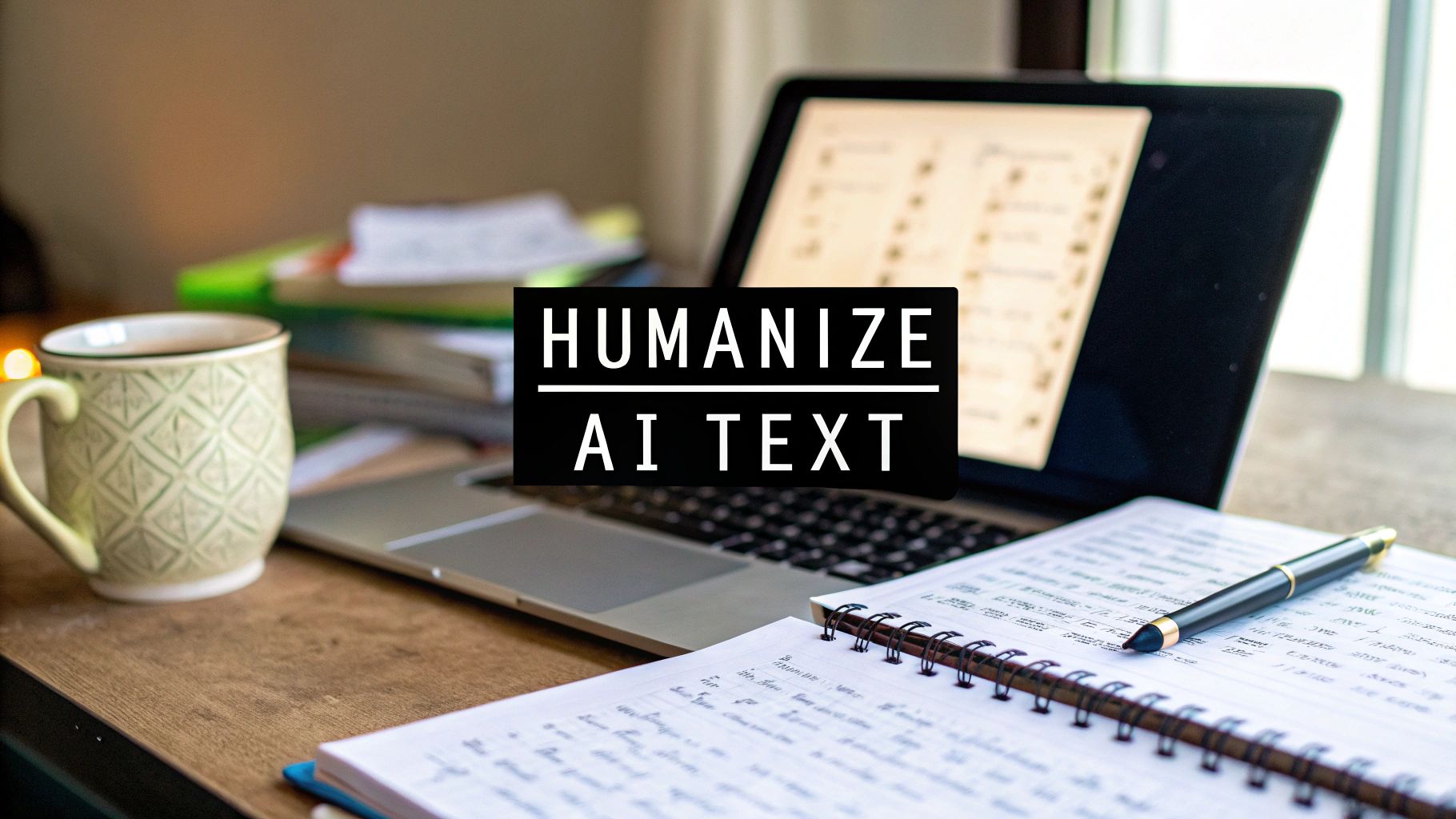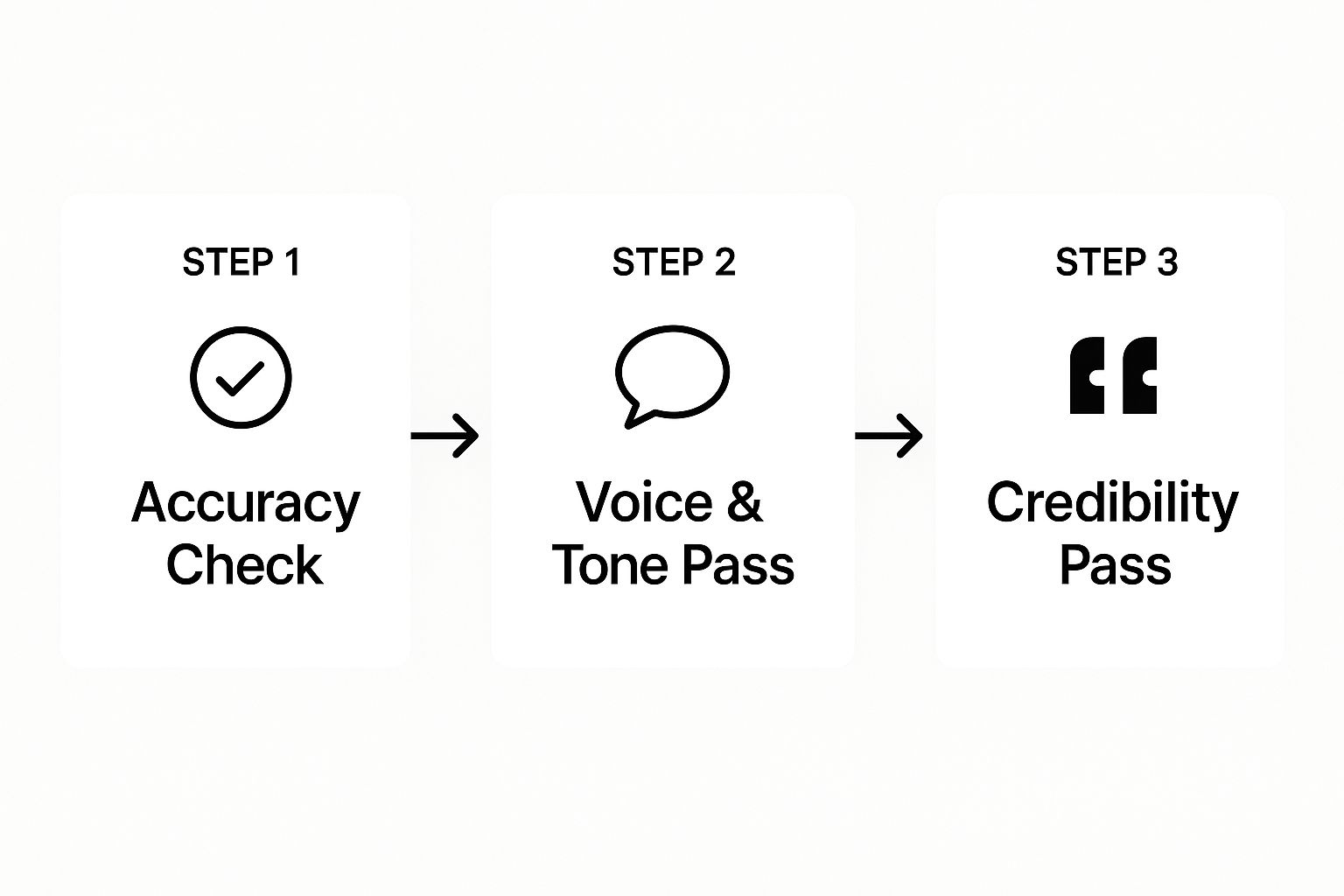
How to Humanize AI Generated Text for Authentic Content
Published on 2025-10-19
Humanizing AI-generated text is all about taking that robotic first draft and molding it into something that sounds natural, feels authentic, and actually connects with people. This isn't just about tweaking a few words; it's a crucial step for building a genuine relationship with your audience and, frankly, getting better results from search engines. It's how you transform sterile, predictable content into something with a real, trustworthy personality.
Why a Human Touch on AI Content Is Essential

AI tools are fantastic for speed and churning out ideas, but let's be honest, their raw output often lacks a soul. It's the human elements—storytelling, a bit of empathy, a unique voice—that grab a reader's attention and build lasting trust. Without that human touch, AI content can feel hollow and disconnected, completely missing the mark.
The tell-tale signs of raw AI text are usually pretty clear once you know what to look for. You’ll see the same sentence structures over and over, a total lack of personality, or a stuffy, formal tone that just doesn't fit your brand. These little things can be a dead giveaway to a reader that they're dealing with a machine, which can tank your credibility in an instant.
The Rise of AI and the Need for Editors
It’s no secret that AI has exploded in the content world. In fact, recent data shows that a whopping 74% of marketers are now using AI tools in their day-to-day work. But here’s the kicker: the same research found that 86% of those marketers spend extra time editing and humanizing that content before it ever sees the light of day.
That editing step isn't just a "nice-to-have"—it's absolutely essential. Raw AI text often sounds robotic and just doesn't have the emotional depth needed to keep readers engaged.
Humanizing AI content isn't about fooling some detection tool. It’s about creating a real connection with your audience. Think of it as the bridge between cold, algorithmic efficiency and warm, authentic communication.
From Robotic to Relatable
The difference between a generic, AI-spit-out paragraph and one that’s been carefully polished by a human is night and day. A raw AI draft might get the facts right, but it won't have the persuasive punch of a well-told story.
This table shows a side-by-side look at the key differences you'll see after putting in the work to humanize your content.
AI-Generated vs Humanized Content Comparison
| Characteristic | Raw AI-Generated Text | Humanized AI Text |
|---|---|---|
| Tone of Voice | Often formal, neutral, or inconsistent. | Consistent, branded, and conversational. |
| Sentence Structure | Repetitive and predictable patterns. | Varied and dynamic sentence lengths. |
| Emotional Appeal | Lacks empathy; purely factual. | Connects with reader pain points and desires. |
| Originality | Can feel generic or recycled. | Includes unique insights, stories, and personality. |
| Flow & Readability | Can be choppy or overly dense. | Smooth transitions and easy-to-scan formatting. |
The goal is to move from the left column to the right, transforming every piece of content into something that truly represents your brand and speaks to your audience.
Here’s a quick real-world example to illustrate the point:
- Raw AI Text: "The product increases efficiency by automating tasks. Users can save time and reduce manual errors, which improves overall workflow."
- Humanized Text: "Imagine reclaiming hours of your week. Our tool handles the repetitive tasks for you, freeing you up to focus on the work that truly matters—all while eliminating those frustrating manual errors."
See the difference? The second one doesn't just list features; it taps into the reader's goals and frustrations. It uses empathy and more vivid language to make a connection. Understanding how to get better outputs from the start, like learning how to tell ChatGPT to write like a human, can give you a much better foundation to build upon. This skill is quickly becoming a must-have for any serious content creator or marketer.
Giving AI-Generated Text a Real Personality (Yours!)

Think of a raw AI draft as a blank canvas. It’s got the structure down, but it’s completely devoid of the quirks, humor, and specific language that make your brand your brand. Humanizing AI text isn't about just fixing grammar; it's about deliberately layering your brand's unique personality over the top.
This is what turns a generic, forgettable article into something that could only have come from you.
Anyone can buy flour and water, but your favorite local bakery has a secret recipe that makes their bread taste just right. Your brand voice is that secret recipe for your content.
First, Know What You Sound Like
You can’t add personality to your writing if you haven't defined what that personality is. So, what does your brand actually sound like? Is it witty and a little sarcastic? Or is it more like a trusted, authoritative professor?
Do you embrace industry jargon because your audience lives and breathes it, or do you pride yourself on breaking things down into simple, accessible language?
Nailing down the answers here is ground zero. If you're struggling, it's worth the time to develop a set of brand voice guidelines. Seriously, this document will make every editing session faster and far more consistent.
Here are a few things to pin down:
- Word Choice: What specific words or phrases do you love? Which ones do you avoid like the plague? A fitness coach might say, "Let's crush your goals," while a financial advisor would probably opt for something a bit more measured.
- Rhythm and Pace: Is your content full of short, punchy sentences that get right to the point? Or do you prefer more descriptive, flowing prose? This choice completely changes the feel of your writing.
- Stories and Examples: Do you share personal anecdotes or customer stories? These are gold for building a genuine connection, and they're the perfect thing to weave into an AI-generated framework.
Pro Tip: Your brand voice is the filter every single piece of AI-generated content needs to pass through. Without it, you’ll just end up sounding like everyone else.
A Quick Example: From Bland to Branded
Let's see how this works in the real world. Imagine you asked an AI to write about the benefits of a new project management tool.
The Original AI Output:
"Our project management software is a robust solution designed to optimize team collaboration and productivity. It features a centralized dashboard, task tracking capabilities, and real-time reporting to streamline workflows and ensure project deadlines are met efficiently."
It's... fine. Correct, but totally sterile. Now, let’s inject two very different brand voices into that same core message.
Voice #1: The Witty & Playful Startup
"Tired of chasing deadlines like they stole your lunch money? Our tool wrangles your team's chaos into one beautiful, organized dashboard. Track tasks, see what’s happening in real-time, and finally stop herding cats via email."
Voice #2: The Authoritative & Expert Consultant
"Effective project delivery hinges on clear communication and data-driven oversight. Our platform provides a centralized command center with robust task tracking and real-time analytics, empowering leaders to mitigate risks and ensure strategic objectives are met on schedule."
See the difference? Both versions communicate the exact same information, but they feel like they come from entirely different companies. The first one uses humor and relatable pain points, while the second builds credibility with precise, professional language.
This is how you make AI content your own. It's about translating a list of features into a feeling that connects with your specific audience.
Refining Sentence Structure and Readability

One of the surest signs you're reading AI-generated content is the rhythm. It’s often flat and monotonous, with sentences of similar length and predictable patterns. It just feels… robotic. And it can put your reader to sleep in a hurry.
If you want your text to feel like a human wrote it, you have to inject some natural cadence. This comes from creating burstiness—a dynamic mix of short, punchy sentences and longer, more descriptive ones. It’s how real people talk and write. A short sentence lands with impact. A longer one then swoops in to add detail, guiding the reader through a more complex thought.
Break Up the Monotony
A great first step is to scan your AI draft for paragraphs where every sentence looks about the same length. Once you spot them, your mission is to surgically restructure them.
Look for opportunities to combine short, choppy sentences into a single, more fluid one. On the flip side, find those long, rambling sentences and split them into two or three crisp, clear points.
For example, the AI might give you this:
- The system is efficient. It helps teams collaborate. It also tracks progress on tasks.
With a little tweaking, it becomes this:
- The system boosts efficiency by helping teams collaborate and track task progress seamlessly.
See the difference? That simple change makes the text flow so much better. Mastering this is a cornerstone of effective business writing tips that ensure your content actually gets read.
Use Active Voice and Smart Transitions
Another dead giveaway of AI writing is its love affair with the passive voice ("The report was written by the team"). Whenever you see this, flip it to the active voice: "The team wrote the report." This small edit makes your writing more direct, confident, and energetic. It puts the doer of the action front and center.
Also, be sure to sprinkle in natural transition words and phrases. Think of words like "however," "for example," "in short," or "on top of that" as signposts for your reader. They build a bridge from one idea to the next, creating a logical flow that AI often struggles to replicate smoothly.
Here's a simple but incredibly powerful trick: read your text out loud. Your ear will instantly catch the awkward phrasing and clunky sentences that your eyes might skim over. If it sounds like a robot when you say it, it's going to feel like one when they read it.
The good news is that technology is getting better at this. The latest AI humanizers are moving beyond just swapping out words. They’re now using more sophisticated methods to vary sentence length and introduce that crucial burstiness, which makes the text far less likely to trigger AI detection. This is the new frontier—bridging the gap between a machine's output and a human's touch.
Building Trust with Expertise and Storytelling
AI is great at pulling together facts and figures, but it can't fake real experience or tell a story that genuinely connects with people. This is where you come in. To really humanize that AI draft, you need to layer in your own unique insights, expert takes, and real-world stories—the stuff that builds trust an algorithm just can't manufacture.
I like to think of an AI draft as the basic frame of a house. All the structural parts are there, but it's cold, empty, and completely impersonal. Your job is to furnish it. You bring in the personal stories, hard-won lessons, and evidence of actual experience that make it feel like a home. This is what turns a generic article into something memorable and truly persuasive.
Weave in Authentic Credibility Markers
Let's be honest, your readers are smart. They can spot recycled, generic information from a mile away. If you want to build real authority, you have to add elements that an AI simply couldn't invent on its own.
These are the kinds of credibility markers that signal to your reader there’s a real expert behind the keyboard:
- Expert Quotes: Go beyond your own voice. Weaving in quotes from other industry leaders or subject matter experts can give your arguments a ton of weight.
- Original Data: Have you run a survey recently? Or do you have internal data you can analyze and share? Presenting your own findings offers unique value no one else can replicate.
- Personal Anecdotes: A short, relevant story from your own professional life can make an abstract concept instantly tangible and relatable for your audience.
Adding these touches proves you’ve done more than just type a prompt into a machine; you’ve invested your real-world knowledge into the content. If you're looking for inspiration, checking out some powerful business storytelling examples can really show you how to blend narrative with information in a compelling way.
Storytelling is the most powerful way to put ideas into the world today. It’s what separates sterile information from transformative insights. When you tell a story, you're not just sharing facts—you're building a connection.
The Undeniable Power of the Human Voice
The data backs this up, too. There's a huge performance gap between purely AI-generated articles and those written or heavily edited by people. In fact, one study showed that human-generated content outperforms AI content by around 47% in user engagement. You can find more details on what Google prefers over at The Ad Firm.
Why the big difference? It’s because an authentic human voice resonates more deeply. Readers connect with nuanced opinions, personal journeys, and credible authorship in a way that AI still struggles to mimic.
At the end of the day, AI is an incredible assistant for getting a first draft done. But it's not the author. Your expertise, your stories, and your unique perspective are the irreplaceable ingredients that build trust and turn casual readers into a loyal audience.
Your Practical AI Content Editing Workflow
Let's get practical. It's one thing to talk about what to do, but it's another to build a repeatable process that actually works. Having a solid workflow is the secret to turning those robotic first drafts into polished content, and doing it efficiently.
This isn't about adding busywork. It's about being smart and methodical. I think of it as a series of "passes," where each round of editing has a single, clear goal. This way, you’re not trying to fix everything at once, and crucial details don't fall through the cracks.
First, A Factual Accuracy Check
Before you even think about style or flow, you have to nail the facts. This is non-negotiable. AI tools are notorious for "hallucinating" data or pulling stats from five years ago. This first pass is your credibility shield.
Your only job here is to play detective. Question every claim. If the AI spits out a statistic, find the original source. If it mentions a study, go read the abstract. This single step is what separates amateur content from professional, trustworthy resources.
Next, The Voice and Tone Pass
Once you're sure the information is solid, it's time to make the content sound like you. This is where the real transformation begins, moving from a generic script to something with personality and a distinct point of view.
I always recommend reading the text aloud at this stage. Does it sound stiff? Awkward? Like a machine? Now's the time to fix it.
- Swap out dull, corporate words for your brand’s unique terminology.
- Sprinkle in a short, relevant story or a personal observation.
- Use questions to draw the reader in and make it feel like a real conversation.
This pass is all about closing the gap between technically correct and authentically yours. It’s the difference between a dry textbook entry and a chat with an expert you trust.
Then, Refine Flow and Readability
With the facts straight and the voice right, the next pass focuses entirely on the reader's journey. How does it feel to read the article? Is it a slog, or does it pull you forward?
This is where you hunt down long, monotonous sentences and break them up. Look for dense "walls of text" and slice them into shorter, more digestible paragraphs. Vary your sentence structure—mix short, punchy statements with longer, more detailed ones.
Integrating this human editing phase into your overall content creation workflow strategies is what will set your content apart.
Finally, The Credibility Pass
Your last run-through is about layering in the proof. This is where you add the unmistakable signs of human expertise that AI simply can't fake. You've already checked the facts, but now you’re adding unique value.
Go through the content one last time and ask: Where can I add an expert quote? Can I insert a link to our own case study here? Is there a spot for a mini-story from a client? This final polish adds the depth and authority that builds real trust.
This entire process can be visualized as a simple, focused flow.

Putting It All Together: The 5-Step Workflow
To make this even more concrete, I've boiled it down into a clear, 5-step process. This is the exact workflow you can follow to take an AI draft from raw output to a published piece you're proud of.
5-Step AI Content Humanization Workflow
| Step | Action | Primary Goal |
|---|---|---|
| 1. Fact-Check | Verify every statistic, claim, and data point against reliable sources. | Eliminate AI "hallucinations" and ensure 100% factual accuracy. |
| 2. Voice & Tone | Rewrite sentences to align with your brand's personality. Read it aloud. | Infuse the content with your unique brand voice so it sounds authentic. |
| 3. Structure & Flow | Break up long paragraphs, add formatting (bullets, bold), and vary sentence length. | Improve readability and keep the reader engaged from start to finish. |
| 4. Add Expertise | Insert unique insights, personal anecdotes, original data, or expert quotes. | Layer in unique value and credibility that only a human can provide. |
| 5. Final Polish | Do a final read-through for grammar, spelling, and typos. Check all links. | Catch any small errors to ensure a professional and polished final product. |
By following this systematic approach, you ensure every piece of content isn't just factually sound and on-brand, but also genuinely helpful and a pleasure to read.
Got Questions About Humanizing AI? We've Got Answers
Stepping into the world of AI-assisted writing can feel like navigating a new frontier. A lot of questions pop up. Let's tackle some of the most common ones with practical, no-fluff answers to help you get it right.
So, How Much Editing Does AI Content Actually Need?
That's the million-dollar question, and the honest answer is: it really depends on the task at hand.
If you've asked an AI to write a simple, fact-based paragraph, you might just need a quick polish to make it sound like your brand. But if you're working on a piece that needs real storytelling, a unique perspective, or your expert opinion, you’ll have to roll up your sleeves and do some heavy lifting.
Here’s my rule of thumb: plan to edit 100% of what an AI gives you. Every single word. Even the most impressive AI draft is just a starting point. Think of it as a solid first draft from a junior writer—it has potential, but it needs your expertise to truly shine.
Can Google Really Tell if I've Used AI?
Yep, they're getting pretty good at it. Search engines can spot the common patterns and quirks of AI-generated text. But here's the thing they care about most: is the content helpful, high-quality, and genuinely useful for the reader?
Google's whole philosophy is built around rewarding content that shows experience, expertise, authoritativeness, and trustworthiness (E-E-A-T). A raw, unedited AI article almost always falls flat on these measures. It lacks the lived-in experience and unique voice that people connect with.
Your goal shouldn't be to "trick an AI detector." It should be to create something so valuable and authentic that it resonates with your audience. When you nail that, search engines are happy to send people your way, no matter how you started the draft.
Focus on weaving in your own insights, original data, and real stories. That's what makes your content stand out to both people and search engines.
Are Those Automated "AI Humanizer" Tools Worth It?
They can be, but they aren't a magic wand. Think of automated humanizer tools as a helpful editing assistant, not a replacement for your own brain.
These tools are great for the grunt work—they can rephrase clunky sentences, swap out repetitive words, and mix up sentence structures to make the text flow a bit better. This can definitely save you time on that initial clean-up pass.
However, an automated tool has its limits. It can't:
- Capture your unique brand voice—the quirks, humor, and tone that make you, you.
- Share a personal story or a hard-won lesson from your own experience.
- Fact-check complex topics or add the kind of deep, expert insights that build trust.
Use these tools to help with the mechanical side of editing. Let them polish the surface. But the real, strategic work of adding soul and substance to your content? That still has to come from you. The final touch that truly helps you humanize AI-generated text is always human.
Ready to create scroll-stopping LinkedIn content that sounds authentically you? autoghostwriter uses powerful AI to give you a head start, so you can focus on adding the personal touch that builds real connections. Start creating engaging content today!